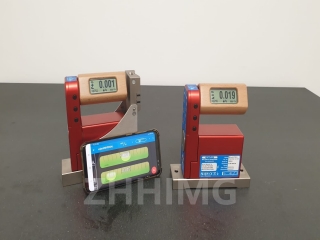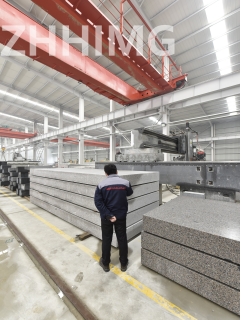Under the strict requirements of high precision and high reliability in the semiconductor industry, although granite is one of the core materials, its properties also bring certain limitations. The following are its main disadvantages and challenges in practical applications:
First, the material is highly brittle and difficult to process
Risk of cracking: Granite is essentially a natural stone with natural micro-cracks and mineral particle boundaries inside, and it is a typical brittle material. In ultra-precision machining (such as nanoscale grinding and complex curved surface processing), if the force is uneven or the processing parameters are inappropriate, problems such as chipping and microcrack propagation are prone to occur, leading to the scrapping of the workpiece.

Low processing efficiency: To avoid brittle fracture, special processes such as low-speed grinding with diamond grinding wheels and magnetorheological polishing are required. The processing cycle is 30% to 50% longer than that of metal materials, and the equipment investment cost is high (for example, the price of a five-axis linkage machining center exceeds 10 million yuan).
Complex structure limitations: It is difficult to produce hollow lightweight structures through casting, forging and other processes. It is mostly used in simple geometric shapes such as plates and bases, and its application is limited in equipment that requires irregular supports or internal pipeline integration.
Second, high density leads to heavy load on the equipment
Difficult to handle and install: The density of granite is approximately 2.6-3.0 g/cm³, and its weight is 1.5-2 times that of cast iron under the same volume. For instance, the weight of a granite base for a photolithography machine can reach 5 to 10 tons, requiring dedicated lifting equipment and shock-proof foundations, which increases the cost of factory construction and equipment deployment.
Dynamic response lag: High inertia limits the acceleration of moving parts of the equipment (such as wafer transfer robots). In scenarios where rapid start and stop are required (such as high-speed inspection equipment), it may affect the production rhythm and reduce efficiency.
Third, the cost of repair and iteration is high
Defects are difficult to repair: If surface wear or collision damage occurs during use, it needs to be returned to the factory for repair through professional grinding equipment, which cannot be handled quickly on site. In contrast, metal components can be repaired immediately through methods such as spot welding and laser cladding, resulting in shorter downtime.
The design iteration cycle is long: The differences in natural granite veins may cause slight fluctuations in the material properties (such as thermal expansion coefficient and damping ratio) of different batches. If the equipment design changes, the material properties need to be re-matched, and the research and development verification cycle is relatively long.
Iv. Limited Resources and Environmental Challenges
Natural stone is non-renewable: High-quality granite (such as "Jinan Green" and "Sesame Black" used in semiconductors) relies on specific veins, has limited reserves and its mining is restricted by environmental protection policies. With the expansion of the semiconductor industry, there may be a risk of unstable raw material supply.
Processing pollution issues: During the cutting and grinding processes, a large amount of granite dust (containing silicon dioxide) is produced. If not handled properly, it may cause silicosis. Moreover, the wastewater needs to be treated by sedimentation before being discharged, increasing environmental protection investment.
Five. Insufficient compatibility with emerging processes
Vacuum environment limitations: Some semiconductor processes (such as vacuum coating and electron beam lithography) require maintaining a high vacuum state inside the equipment. However, the micro-pores on the surface of granite may adsorb gas molecules, which are slowly released and affect the stability of the vacuum degree. Therefore, additional surface densification treatment (such as resin impregnation) is necessary.
Electromagnetic compatibility issues: Granite is an insulating material. In scenarios where static electricity discharge or electromagnetic shielding is required (such as wafer electrostatic adsorption platforms), metal coatings or conductive films need to be compounded, increasing structural complexity and cost.
Industry response strategy
Despite the above-mentioned shortcomings, the semiconductor industry has partially made up for the deficiencies of granite through technological innovation:
Composite structure design: It adopts the combination of "granite base + metal frame", taking into account both rigidity and lightweight (for example, a certain photolithography machine manufacturer embeds an aluminum alloy honeycomb structure in the granite base, reducing the weight by 40%).
Artificial synthetic alternative materials: Develop ceramic matrix composites (such as silicon carbide ceramics) and epoxy resin-based artificial stones to simulate the thermal stability and vibration resistance of granite, while enhancing processing flexibility.
Intelligent processing technology: By introducing AI algorithms to optimize the processing path, stress simulation to predict crack risks, and combining online detection to adjust parameters in real time, the processing scrap rate has been reduced from 5% to below 1%.
Summary
The shortcomings of granite in the semiconductor industry essentially stem from the game between its natural material properties and industrial demands. With the advancement of technology and the development of alternative materials, its application scenarios may gradually shrink towards "irreplaceable core reference components" (such as hydrostatic guide rails for photolithography machines and ultra-precision measurement platforms), while gradually giving way to more flexible engineering materials in non-critical structural components. In the future, how to balance performance, cost and sustainability will be a subject that the industry continues to explore.
Post time: May-24-2025

